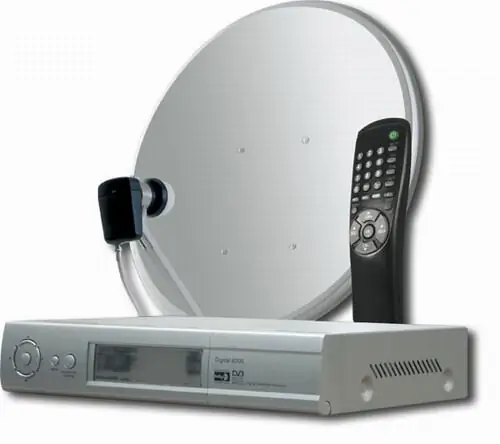- Author Lauren Nevill [email protected].
- Public 2023-12-16 18:48.
- Last modified 2025-01-23 15:15.
In the modern world, satellite Internet is becoming not just a popular solution, but a real necessity for many users. We will tell you how to set up satellite Internet yourself and completely free of charge. Since the Eutelsat W6 (21.5) satellite is the most common among satellite Internet users, we will consider the setup using its example.

It is necessary
- - plate,
- - converter,
- - cable,
- - bracket,
- - DVB card,
- - anchor,
- - F-ki,
- - heat shrink
Instructions
Step 1
To start setting up satellite Internet, make sure that you have all the necessary equipment: a plate (diagonal 90cm - 1.20m), converter, cable, bracket, DVB card, anchor, F-ki, heat shrink.
Step 2
Before you start directly setting up satellite Internet, you need to establish a terrestrial channel (GPRS, DialUp, etc.). Your provider or mobile operator will tell you how to do this.
Step 3
The next stage is the stage of setting up a DVB card. Install the DVB card into a free PCI slot, preferably as far away from the TV tuner as possible to avoid interference. Next, take the disk that comes with the DVB card and install the drivers from this disk. The DVB card must be defined as a network device. After you have installed the drivers, a red icon will appear in the tray bar. Now right-click on this icon and select the Setup4PC line in the tab that opens.
Step 4
In the window that appears, select "Add", enter the name of the satellite "Eutelsat W6", leave the rest unchanged. Click OK.
Step 5
Click "Transponder Management" and in the window that appears, click "Add". Enter a new transponder (11345, speed 28782, polarization "H" (Horizontal). Further, if the satellite dish is tuned correctly, you will see the signal strength bar (Signal Quality). Click "OK", "Close".
Step 6
Next, in the "Setup4PC" window, select the "Data Services" button. In the window that appears, select the provider name and click "Add". Enter the name "SpaceGate".
Step 7
Now in the "Transponder" window, click the "Add" button and in the window that opens, select the transponder into which you clocked the frequencies. Enter another name to display in the tray bar. Click OK.
Enter "PID List", "1024" and press the "Insert" key. Then "OK" and "Close".
Step 8
Now set up your network connection. Go to the Start Menu // Settings // Network Connections. Right click on "Network Connections" and go to "Properties". In the General tab, select the TCP / IP protocol and click Properties. Type in the IP address that is on the personal settings sheet that comes with the DVB card. And your subnet mask should be 255.255.255.0. Click OK.
Step 9
Download the GlobaX program from the Internet. Go to the directory where you installed GlobaX and find the "globax.conf" file. Open it in a regular notepad, and enter the following data:
[server]
port = 2001
log = client.log
[remote]
name = globax
server = (individual for each subscriber, comes with a DVB card)
login = (individual for each subscriber, comes with a DVB card)
passwd = (individual for each subscriber, comes with a DVB card)
speed_in = 100000
speed_out = 4096
mtu = 1500
mru = 1500
[local]
remote = globax
port = 127.0.0.1:3128
service_int = 0
[local]
remote = globax
port = 127.0.0.1:1080
service_int = 2
Save and close the document.
Step 10
Configure your browser if it does not automatically accept the settings.
Open your browser, click on "Tools" // "Internet Options", select the "Connections" tab and find a terrestrial connection (DialUp, GPRS). Highlight it and click the Settings button. Enter the address 127.0.0.1 and port 3178. Click "OK".
Step 11
Connect to the internet. After the computer is connected, pay attention to the driver icon in the tray bar, it should be green. If so, connect a land line. Then go to the directory, run the "GlobaX" program, click "Start". Done! Open your browser and enjoy satellite Internet!






